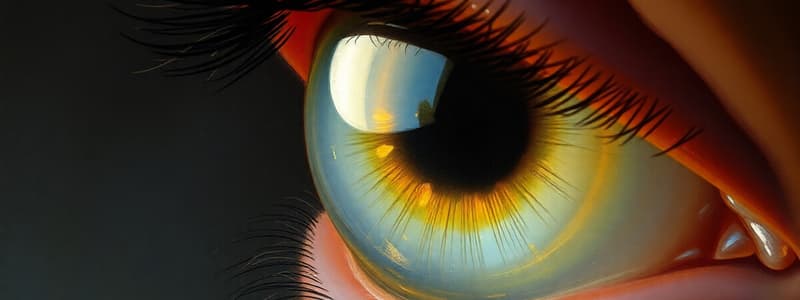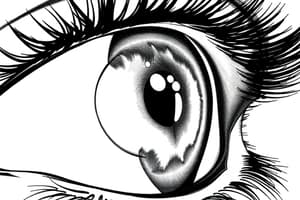Podcast
Questions and Answers
What happens to the curvature of the crystalline lens when the tension in the ligaments is at maximum?
What happens to the curvature of the crystalline lens when the tension in the ligaments is at maximum?
- The lens flattens. (correct)
- The lens remains unchanged.
- The lens becomes more spherical.
- The lens increases in size.
What is the maximum distance from the eye where objects form sharp images called?
What is the maximum distance from the eye where objects form sharp images called?
- Far point (correct)
- Optical limit
- Focus point
- Vision range
What condition is characterized by a lack of appropriate accommodation in the eyes due to aging?
What condition is characterized by a lack of appropriate accommodation in the eyes due to aging?
- Astigmatism
- Myopia
- Presbyopia (correct)
- Hyperopia
Which factor does NOT contribute to the loss of accommodation with age?
Which factor does NOT contribute to the loss of accommodation with age?
If Beth's glasses are 2.5 cm in front of her eyes and she holds the newspaper 30 cm away, what is the object distance used in the calculation of her glasses' optical power?
If Beth's glasses are 2.5 cm in front of her eyes and she holds the newspaper 30 cm away, what is the object distance used in the calculation of her glasses' optical power?
What is the sign convention for the distance from a lens to a virtual image?
What is the sign convention for the distance from a lens to a virtual image?
Which type of lens is used to correct hyperopia?
Which type of lens is used to correct hyperopia?
In the thin-lens equation, what does a positive focal length (f) indicate?
In the thin-lens equation, what does a positive focal length (f) indicate?
What is the optical power of Beth's new glasses, calculated using the thin-lens equation?
What is the optical power of Beth's new glasses, calculated using the thin-lens equation?
What condition results from a focal length that is too long, causing difficulty in seeing close objects?
What condition results from a focal length that is too long, causing difficulty in seeing close objects?
What is the primary function of the crystalline lens in relation to light?
What is the primary function of the crystalline lens in relation to light?
Which model of the eye is described as having a uniform refractive index within the crystalline lens?
Which model of the eye is described as having a uniform refractive index within the crystalline lens?
What is the formula used to calculate the refractive power of an interface?
What is the formula used to calculate the refractive power of an interface?
What is the refractive power calculated for the air/anterior cornea interface?
What is the refractive power calculated for the air/anterior cornea interface?
Which model of the eye contains only one refractive interface?
Which model of the eye contains only one refractive interface?
What is the condition where a person can see near objects clearly, but not distant ones?
What is the condition where a person can see near objects clearly, but not distant ones?
What is the far point distance for a person suffering from refractive myopia who cannot see objects clearly beyond 10 meters?
What is the far point distance for a person suffering from refractive myopia who cannot see objects clearly beyond 10 meters?
What optical power of corrective lenses is required for a person whose far point is at 10 meters and needs to see clearly at 100 meters?
What optical power of corrective lenses is required for a person whose far point is at 10 meters and needs to see clearly at 100 meters?
Which type of photoreceptor in the human eye is primarily responsible for color vision?
Which type of photoreceptor in the human eye is primarily responsible for color vision?
What is the near point distance considered normal for the human eye?
What is the near point distance considered normal for the human eye?
Flashcards
Refractive Power of an Interface
Refractive Power of an Interface
The refractive power of an interface between two media is determined by the difference in refractive indices of the two media and the radius of curvature of the interface.
Reduced Eye Model
Reduced Eye Model
The simplest eye model; it considers only one refractive interface at the cornea, and distances are relative to this interface.
Schematic Eye 1
Schematic Eye 1
An eye model where the refractive index within the crystalline lens is uniform and the eye has four interfaces.
Power (Diopters)
Power (Diopters)
Signup and view all the flashcards
Gullstrand Exact Eye
Gullstrand Exact Eye
Signup and view all the flashcards
Accommodation (eye)
Accommodation (eye)
Signup and view all the flashcards
Crystalline Lens
Crystalline Lens
Signup and view all the flashcards
Presbyopia
Presbyopia
Signup and view all the flashcards
Far Point (FP)
Far Point (FP)
Signup and view all the flashcards
Near Point (NP)
Near Point (NP)
Signup and view all the flashcards
Real Image Distance
Real Image Distance
Signup and view all the flashcards
Virtual Image Distance
Virtual Image Distance
Signup and view all the flashcards
Convex Lens Focal Length
Convex Lens Focal Length
Signup and view all the flashcards
Concave Lens Focal Length
Concave Lens Focal Length
Signup and view all the flashcards
Object Distance
Object Distance
Signup and view all the flashcards
Myopia (Nearsightedness)
Myopia (Nearsightedness)
Signup and view all the flashcards
Concave Lens Correction
Concave Lens Correction
Signup and view all the flashcards
Optical Power (Diopters)
Optical Power (Diopters)
Signup and view all the flashcards
Rods and Cones
Rods and Cones
Signup and view all the flashcards
Normal Vision Far Point
Normal Vision Far Point
Signup and view all the flashcards




